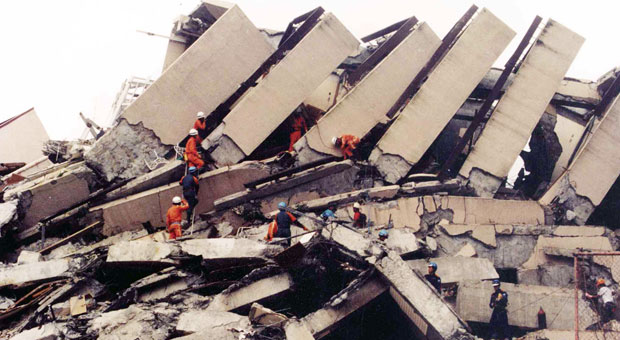Visualize ‘Big One’ by multiplying quake damage 25 years ago

AND THE EARTH MOVED The collapsed Hyatt Hotel in Baguio City was a grim reminder of the 7.9-magnitude quake that hit Luzon 25 years ago on Thursday, toppling several buildings and schoolhouses and killing at least 1,600 people in Northern Luzon. Volcanologists have warned of a similar catastrophe should another quake hit this summer capital where congestion has led people to build directly over sinkholes. Baguio, geologists said, straddles four major fault lines. INQUIRER PHOTO
CITY OF SAN FERNANDO, Pampanga—People who take lightly the safety preparations for a strong earthquake hitting Metro Manila and Calabarzon may want to visualize the risks by multiplying the impact of the 1990 earthquake in central and northern Luzon several times over, the country’s chief volcanologist said.
The 7.7-magnitude earthquake on July 16, 1990, clearly demonstrated what powerful earthquakes can do, said Renato Solidum Jr., director of the Philippine Institute of Volcanology and Seismology (Phivolcs).
Caused by strikes and slips in the Digdig Fault and with an epicenter in Rizal, Nueva Ecija province, the 1990 earthquake was the last major event of its kind that shook Luzon, he said.
The 1990 earthquake devastated Baguio City, which was 50 km north of the epicenter in Nueva Ecija.
“What is important is we appreciate scenarios,” Solidum said.
The 1990 earthquake prompted Phivolcs to develop a software for Rapid Earthquake Damage Assessment System (Redas). A set of 12 reports on the 1990 earthquake (https://202.90.128.66/1990LuzonEQ_Monograph/foreword.html) is posted on http:/www.phivolcs.dost.gov.ph.
Many lessons
Solidum said the 1990 earthquake provided many lessons, like the need to secure water systems, power sources, communication and transport networks.
He said the threat to lives and property could be reduced by using proper construction materials, methods and design.
Another form of mitigation is decongesting the Port of Manila by expanding activities at the Subic Bay Freeport in Zambales and Batangas port.
Ground shaking, rupture, liquefaction and landslides left 1,283 people dead, 2,786 injured, 321 missing and P18.7 billion in damage to infrastructure and property, according to the then National Disaster Coordinating Council and the National Economic and Development Authority.
The next strong earthquakes struck Mindoro island in 1994, Negros island in 2012 and Bohol in 2013.
“The youth now don’t have any experience in strong ground shaking. Essentially, there’s a need to make sure they are aware of the potential hazards and effects of the ‘Big One,’” Solidum said in a telephone interview on Wednesday.
The “Big One” applies a scenario where movements along the Valley Fault System (VFS) could trigger a 7.2-magnitude quake. The East Valley Fault straddles 10 kilometers in Rizal province while the West Valley Fault runs over more than 100 km through the provinces of Bulacan, Rizal, Cavite and Laguna and Metro Manila.
Higher risk
The potential risk from a 7.2-magnitude quake is higher because more people live in areas where the VFS runs and more structures are exposed to the fault, Solidum said. Metro Manila alone has over 10 million people.
The cities of Baguio in the Cordillera region, Dagupan in Pangasinan province and Cabanatuan and San Jose in Nueva Ecija province that bore the brunt of the disaster that preceded the eruptions of Mt. Pinatubo in June 1991 had 3 million residents in 1990, records showed.
The VFS is ripe for movement, Solidum said, citing a pattern of moving every 600 years.
Minus interventions and should the earthquake strike at night when most people are resting, Phivolcs projected that it could kill 31,000 people and seriously injure 130,000 others in Metro Manila alone.
The impact is not confined to faults, Solidum said. “These radiate beyond [the faults],” he said.
For instance, the Aug. 2, 1968, earthquake, felt at Intensity VIII, had its epicenter in Casiguran, Aurora. But ground shaking was felt as far as Manila, where 270 people were killed and 261 others were hurt mostly from the collapse of the Ruby Tower in Binondo district.
Metro-wide drill on July 30
Asked if local governments were doing enough to prepare people to respond to the “Big One,” Solidum said ongoing preparations “need to be sustained” at the levels of individuals, families, schools, offices, villages and the private sector.
He said a nationwide simultaneous earthquake drill on July 23 and a Metro Manila-wide drill on July 30 would help people prepare and save themselves and others.
RELATED STORIES
MMDA urges public: Take earthquake warnings seriously
Do you live in quake zone? New Phivolcs maps trace 100-km West Valley Fault